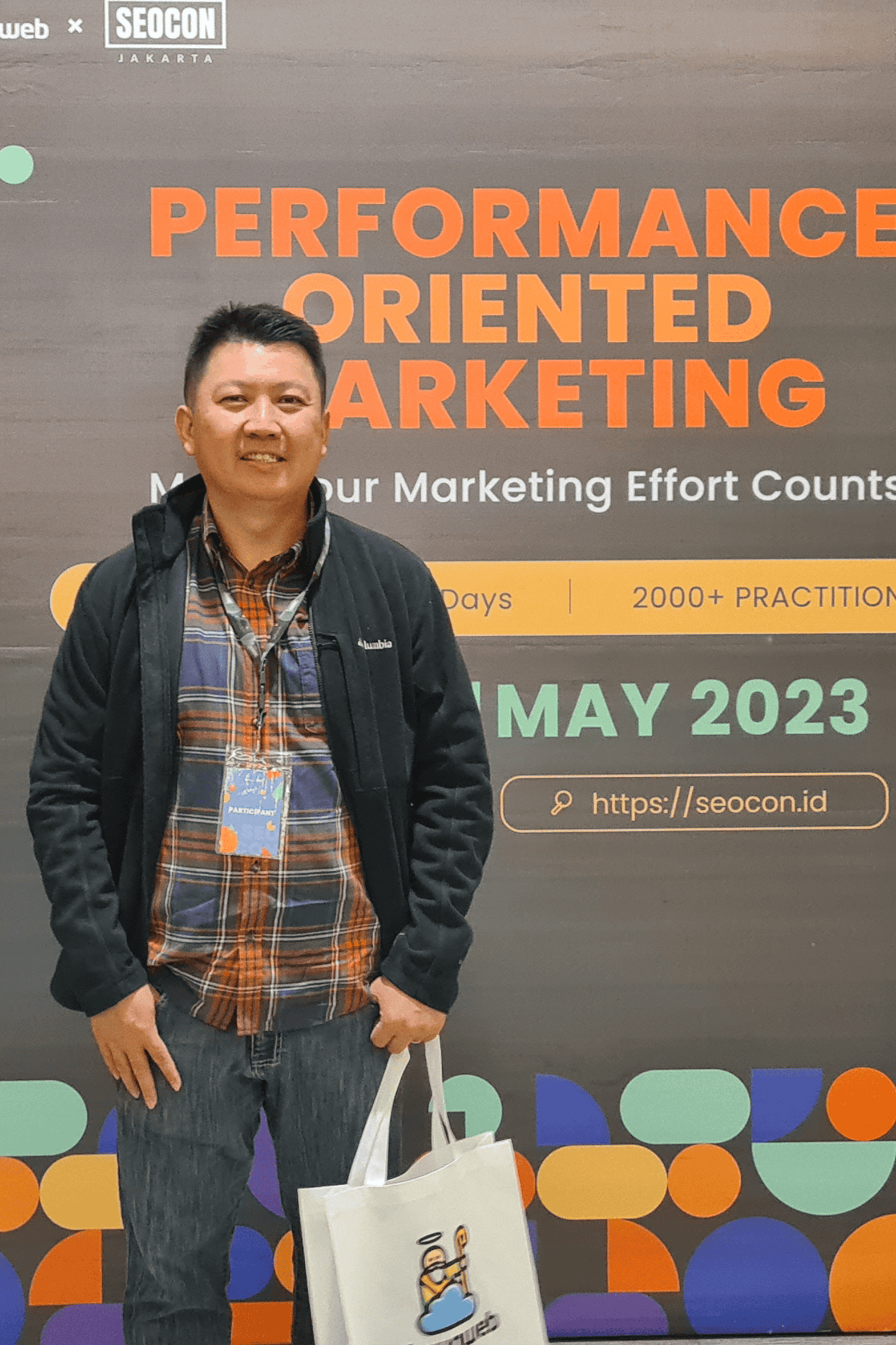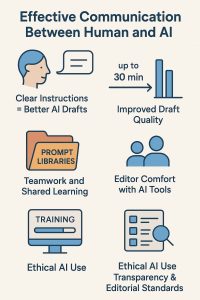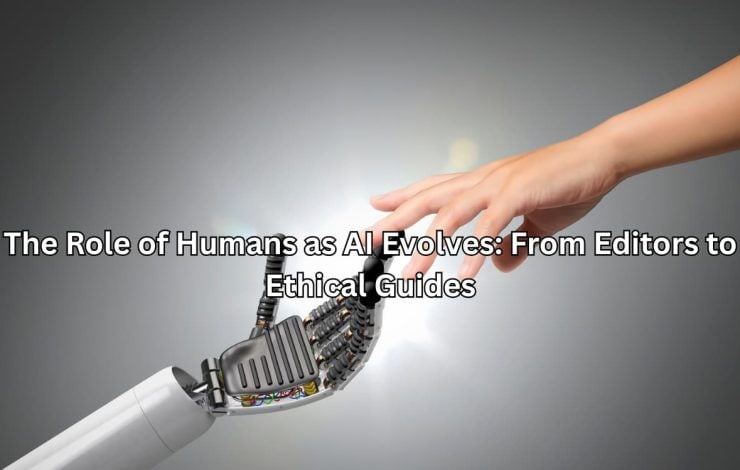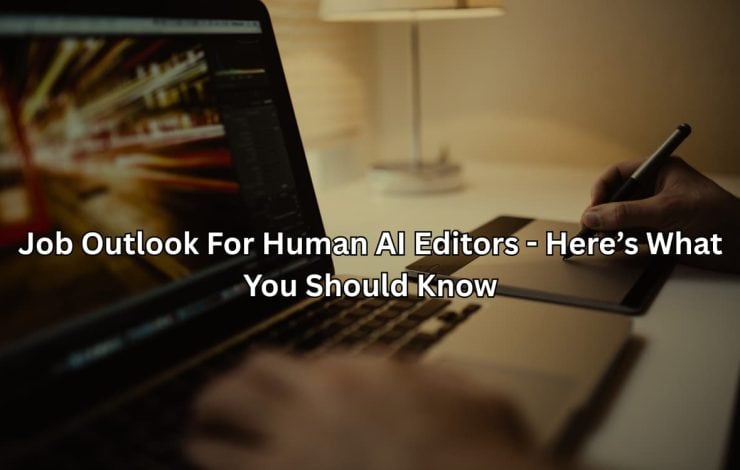Editing isn’t what it used to be, not since AI stepped into the picture. It’s a bit like having a super-fast research assistant who sometimes needs to be told “slow down.” Sure, AI churns through drafts and numbers at lightning speed, that’s just fact.
But there’s still no replacement for an editor’s gut feeling about what works and what doesn’t. Real editors bring the human touch, they know when something sounds off or when a piece needs more heart.
Teams at places like Jet Digital Pro have figured out this dance between machine speed and human judgment, and they’re getting work done faster without sacrificing quality. Want to see how this partnership really works? Keep reading.
Key Takeaways
- AI might do the heavy lifting with speed, but humans keep their hands on the creative steering wheel.
- When editors and AI bounce ideas back and forth, the writing gets sharper each time around.
- Setting clear boundaries between machine tasks and human judgment makes the whole editing process run smoother.
Human-AI Collaboration in Editing: Efficient Content Creation Workflow
Most editors used to work alone with just their red pens and instincts, but that’s changing fast. AI’s jumped in as a partner, not replacing anyone, just making the work flow better. Think of it like having a really fast first reader who can spot typos and run numbers while the editor focuses on making the writing sing. It’s not about AI taking over; it’s about each player bringing their best game to the table.
At Jet Digital Pro, we’ve got this down to a science. AI throws together the first draft (in about 3 minutes flat), then our editors jump in with their expertise. They’ll polish it up, double-check the facts, and add those creative touches that no machine can match. Back and forth it goes until everything’s just right. That’s where the magic happens, right in that sweet spot between computer speed and human wisdom.
What is the Human-AI Collaboration Entity in Editing?
Definition of Human-AI Collaboration Entity in Editing
Think of it as a tag-team match, AI and human editors working together, each doing what they’re good at. It’s not just about having AI tools; it’s about knowing when to use them and when to trust human judgment. This shift is shaping the future of human-AI content editors, showing how the process works better than either side going solo.
Attributes of Human-AI Collaboration Entity in Editing
- Iterative Loop Attribute: The back-and-forth never really stops. AI suggests something, editors tweak it, and the AI picks up new tricks along the way.
- Role Differentiation Attribute: Everyone’s got their lane, AI handles the grunt work while humans bring the creative spark and fact-checking expertise.
- Explainability Attribute: Good AI tools show their work (like those geometry problems in high school), so editors aren’t left guessing why something got flagged.
- Collaborative Workflow Attribute: There’s a rhythm to it, clear steps that keep everything moving smoothly between machine and human hands.
- Cognitive Support Attribute: AI takes care of the boring stuff (like checking grammar 500 times), freeing up editors to focus on making the writing actually good.
- Application Scope Attribute: This teamwork shows up everywhere, from academic papers to news stories, blog posts to corporate reports, pretty much anywhere words need polishing. [1]
How Does the Iterative Loop Entity Operate in Human-AI Collaboration?
Role of AI in Generating Initial Drafts
When a new project lands on the desk, AI kicks things off by spitting out a rough draft in minutes (not hours). It’s like having an eager intern who works at warp speed, maybe not perfect, but definitely beats staring at a blank screen. The AI pulls from its vast knowledge base to lay down the basics, whether it’s a 500-word blog post or a 10-page technical report.
Human Editor’s Role in Refining Content
This is where the real craft comes in. Human editors don’t just clean up grammar; they’re the ones who know when something sounds off or when a metaphor falls flat.
They’ll catch those subtle things AI misses, like whether a joke might not land right or if a reference might offend someone. Plus, they’re the ones who make sure the writing actually connects with real people, not just algorithms.
Feedback Cycle Between Human and AI
Every time an editor accepts or rejects an AI suggestion, it’s like teaching a very fast student. The AI starts picking up patterns, learning that this client prefers shorter sentences, or that industry jargon needs explaining.
Sometimes it’s as simple as clicking ‘accept’ or ‘reject,’ other times it means typing out why something doesn’t work. Either way, the AI gets a little smarter with each round.
Benefits of Iterative Loop
The whole process just works better than the old way. What used to take days now takes hours, and the quality’s actually gone up, not down. Editors aren’t wasting time fixing basic mistakes, they’re focusing on making good content great.
Plus, once the AI learns a company’s style guide or brand voice, it starts hitting the mark more often on the first try. The best part? The more rounds of feedback, the smoother everything runs.
How is Role Differentiation Entity Defined in Human-AI Editing?
AI Assistance in Idea Generation and Data Analysis
Let’s face it, computers are really good at churning through mountains of data. They’ll spot trending topics, pull together research, and even sketch out rough outlines in seconds flat. It’s like having a research department that never sleeps, giving editors a solid foundation to build on.
The AI might suggest 20 article ideas before the first cup of coffee’s finished, complete with supporting stats and potential angles. [2]
Human Editorial Control in Creative Direction and Fact-Checking
Nobody wants a robot deciding what feels right. That’s where human editors shine, they’re the ones who know when something sounds too stiff or when a source seems sketchy.
They’ll catch those little details that matter, like whether a quote’s taken out of context or if a story needs more heart. And when it comes to making tough calls about sensitive topics? That’s where the skill gap for human-AI editors becomes clear, because some editorial judgment can’t be automated.
Integration in Balancing AI and Human Contributions
The sweet spot happens when neither side tries to do everything. AI handles the heavy lifting, grammar checks, readability scores, basic research, while editors focus on the craft of storytelling. Sometimes the AI suggests a great phrase that the editor would’ve missed, and sometimes the editor knows exactly why the AI’s perfect-looking sentence just doesn’t work.
What Explainability Entity Enhances Trust in Human-AI Collaboration?
Explainable AI Outputs (e.g., Visual Heatmaps)
Gone are the days of mysterious AI suggestions. Modern editing tools show their work, highlighting potential issues with clear visuals. Maybe it’s a heat map showing where readers might get lost, or color-coded sections flagging tone inconsistencies. It’s like having an associate editor who always explains their reasoning.
Human Decision-Making Enabled by Explainability
When editors can see why AI flagged something as problematic, they make better calls. Instead of just accepting or rejecting blindly, they’re working with actual insights. That might mean understanding why a paragraph got marked as too complex (reading level: grade 16) or seeing exactly which phrases could come across as biased.
Trust-Building in Collaborative Editing
Nobody likes working with a know-it-all who won’t explain their thinking. When AI tools show their reasoning, editors actually start to trust them more. They’ll learn which suggestions to take seriously (like spotting passive voice) and which ones might need a more human touch (like deciding if a joke lands right).
How are Collaborative Workflow Entities Structured for Optimal Editing?
Role Definition in Workflow Design
There’s no room for confusion about who does what. It’s pretty straightforward: AI jumps in first with the rough draft and basic checks, then human editors take over for the real crafting.
The whole process flows like a well-oiled machine, with clear handoffs at each stage. Teams know exactly when to let the AI do its thing (like at 3 AM when a draft needs to be ready for morning review) and when human eyes need to take a closer look.
Quality Standards in Workflow Management
Every piece needs to hit the mark, whether it’s a quick blog post or a detailed white paper. The AI’s trained to flag anything that doesn’t match the style guide (which can run up to 50 pages at some places), while editors keep an eye on the bigger picture, making sure everything stays on-brand and actually makes sense to real readers. It’s about maintaining those high standards without getting bogged down in the details.
Continuous Learning for Workflow Improvement
Nothing stays the same for long in this field. Last month’s perfect workflow might need tweaking today. As AI tools get smarter (and they do, sometimes weekly), the whole system shifts to take advantage of new features. Smart teams keep track of what’s working and what isn’t, adjusting their approach based on real results, not just gut feelings.
How Does Cognitive Support Entity Reduce Human Editorial Burden?
Automated Task Handling by AI
Remember when editors had to manually check every single comma and citation? Those days are gone. AI handles all that grunt work now, spelling, grammar, formatting, even checking if links are broken. It’s like having a really thorough assistant who never gets tired of running through checklists (and can do it in seconds instead of hours).
Human Focus on Strategic and Creative Tasks
With the basics covered, editors can finally focus on what they do best, making content shine. They’re free to think about bigger questions: Does this story flow? Will readers care? Is there a better way to explain this complex topic? Instead of hunting down missing Oxford commas, they’re crafting compelling narratives and making sure the message actually lands.
Productivity Enhancement Through Cognitive Support
It’s simple math, when you’re not spending 80% of your time on mechanical tasks, you can do more of the important stuff. Editors aren’t just pushing out more content; they’re producing better work because they’ve got the mental energy to focus on quality. Some teams report finishing projects in half the time while actually improving their standards.
What are Application Entities of Human-AI Collaboration Across Editing Fields?
Academic Writing Application
Walk into any university writing center today and you’ll see this partnership at work. AI plows through research databases in minutes, pulling relevant studies and suggesting citations. Meanwhile, professors and editors make sure everything holds up to academic scrutiny.
They’re the ones who know when a paper’s argument doesn’t quite connect or when the methodology section needs more detail. One professor mentioned saving about 15 hours per week on basic editing, leaving more time for deep analysis.
Creative Story Writing Application
The creative process looks different these days. AI might throw out 50 plot twists in five minutes, but it takes a human editor to know which ones won’t put readers to sleep. While AI can suggest character backgrounds or dialogue options, editors shape those raw ideas into something that actually moves people.
They’re the ones who know when to slow down for emotional impact or when to cut a scene that’s technically perfect but dramatically flat.
Digital Media Creation Application
Online content moves fast, really fast. AI helps keep up by handling the technical stuff like meta descriptions and keyword density (try hitting 2% naturally). But human editors still craft those scroll-stopping headlines and make sure everything sounds like it came from actual humans, not robots.
They’ll catch those moments when AI-suggested optimization would make a headline sound ridiculous just to please search engines.
Complex Task Editing Application
Are You a Digital Agency?
White Label SEO Content Services for Agencies
Scalable, customizable, and results-driven content solutions for your clients.
Big projects need both brains and brawn. When you’re dealing with a 200-page technical manual or a corporate report with 57 stakeholders, AI keeps track of all the moving parts. It’ll flag inconsistencies across chapters and keep formatting straight, while editors focus on making complex ideas clear and ensuring everything aligns with company goals.
How to Maximize Value from Human-AI Collaboration Entities in Editing?
Effective Communication Between Human and AI
It’s like training a new team member, the clearer the instructions, the better the results. Editors who take time to fine-tune their AI prompts (sometimes spending up to 30 minutes crafting the perfect input) get way better first drafts.
In fact, many teams are already collaborating with a human-AI editor through shared prompt libraries, where lessons learned are passed along to sharpen results.
Training for Human Editors on AI Tools
Nobody wants to look like they don’t know what they’re doing with new tech. Smart organizations invest time in getting editors comfortable with AI tools, not just the basics, but the advanced features too. When editors really know their way around these tools, they can spot potential problems before they become actual problems.
Monitoring AI Performance and Bias
Trust but verify, that’s the rule here. Good editors keep an eye out for AI blind spots, like when it consistently overlooks certain perspectives or leans too hard into particular phrases. Some teams run monthly audits, checking a random sample of AI-assisted content for quality and fairness.
Ethical Use of AI in Content Editing
There’s a line between helpful AI and hidden AI, and readers deserve to know where that line is. The best teams are upfront about their AI use, maintain clear guidelines about what AI can and can’t do, and never let automation compromise their editorial standards. It’s about using AI to enhance human judgment, not replace it.
FAQ
How does human-AI collaboration change the way editors work with drafts?
Human-AI collaboration shifts editing from a one-direction process to an interactive exchange. Editors can now use AI-assisted editing to review text, catch mistakes, and suggest changes while keeping human editorial control.
Generative AI tools give AI writing assistance that offers phrasing options, but human editorial input still drives the final voice. This balance creates a human-AI workflow where AI editing algorithms help with proofreading while humans refine tone and clarity.
Can AI-assisted editing support creative storytelling without losing human style?
AI-assisted storytelling depends on human-AI interaction that blends AI text generation editing with human creativity AI. AI editing workflows allow writers to draft faster, but iterative human-AI editing ensures originality.
Editors use AI-assisted proofreading to polish details while keeping the personal touch intact. Collaborative content creation works best when explainable AI editing makes suggestions and human feedback AI confirms narrative flow, keeping creative AI collaboration consistent with author intent.
What role does human oversight play in AI-assisted content workflows?
Need a Strategic SEO Content Partner?
Let’s craft SEO content that ranks, converts, and grows your brand.
Talk to UsHuman oversight in AI is not just about catching errors, it is about guiding AI editing models to respect meaning and context. In AI-assisted content workflows, AI-powered editing speeds up repetitive tasks, but human-AI content editing ensures accuracy.
Editors use AI suggestion editing to review text, yet rely on human feedback in AI to safeguard tone. This human-in-the-loop AI approach maintains trust while keeping AI editing productivity in balance with human-AI communication.
How can AI editing collaboration tools improve quality control across projects?
AI editing collaboration tools help scale review processes by combining AI content optimization with human-AI content synergy. Editors use AI editing accuracy checks for grammar, but AI content verification still requires human editorial decision-making.
With AI content quality control, editorial AI tools highlight inconsistencies while human-AI coediting ensures context. AI editorial assistance works best when collaborative AI editing solutions include a writing feedback loop that supports AI content review and human-AI trust.
Why is balancing human creativity with AI writing enhancement difficult?
Balancing human creativity AI with AI writing enhancement means setting clear boundaries in collaborative AI editing solutions. AI language models editing can suggest structure and flow, but human editorial input defines originality.
Human-AI content synergy depends on AI-assisted creativity for drafting, yet human-AI editing balance ensures that final choices remain human. AI editorial innovation works when AI drafting assistance supports expression without replacing author control, creating a strong human-AI partnership.
Conclusion
At Jet Digital Pro, we help digital agencies scale content production with precision. Our process blends AI’s speed with an 11-step human editing workflow, ensuring every piece is accurate, creative, and Google-resilient.
From keyword research to ethical link building and publishing, we manage the entire process so your team can focus on growth. Ready to streamline content creation with a trusted partner? Contact us today.
References
- https://pmc.ncbi.nlm.nih.gov/articles/PMC12292075/
- https://www.sciencedirect.com/science/article/pii/S2666990024000120
Related Articles
- https://jetdigitalpro.com/future-of-human-ai-content-editors/
- https://jetdigitalpro.com/skill-gap-for-human-ai-editors/
- https://jetdigitalpro.com/collaborating-with-a-human-ai-editor/
P.S – Whenever you’re ready,
we’re here to help elevate your SEO content.
Partner with us for strategic, scalable content that drives real organic growth.
Contact Us Now






